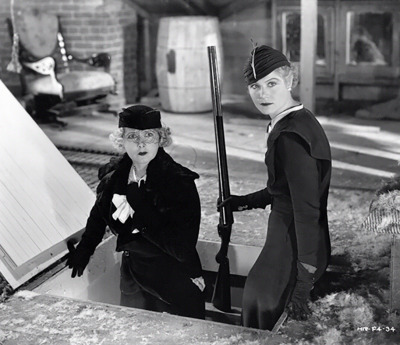Variations on the same theme: Pépé Le Moko (1937) and Algiers (1938)
Todos sabemos que os norte-americanos não gostam de assistir a
filmes com legendas. Todos também sabemos que os chefes dos estúdios estão
sempre de olho no mercado estrangeiro, procurando por inspiração e sucessos
para fazer remakes. Em 1938, Hollywood fez um remake de um filme que havia
estreado apenas um ano antes na França. “Argélia” é um remake fidelíssimo,
quase cena a cena, de “O Demônio da Algéria” (sic), que ainda consegue ser
cinco minutos mais longo que o original. Ambos contam com ótimas performances e
alguns nomes nos bastidores que merecem ser destacados.
Nos últimos dez anos, cinco detetives tentaram
e falharam em capturar o ladrão Pépé Le Moko (Jean Gabin / Charles Boyer). Seu
esconderijo é bem conhecido: é a Casbah, bairro labiríntico de Argel onde vivem
quarenta mil pessoas. Como dito em “Argélia”, a polícia não pode simplesmente
entrar no bairro e prender Pépé porque “não se pode prender um rei no seu
próprio palácio”.
In the last two years, five detectives tried and
failed to capture the thief Pépé Le Moko (Jean Gabin / Charles Boyer). His hiding place is well known:
it’s the Casbah, a labyrinthine district of Argel where forty thousand people
live. As it’s said in “Algiers”, the police can’t simply invade the Casbah and
arrest Pépé because “you can’t arrest a king in his own palace”.
Uma noite, enquanto fugia de um grupo de
policiais, Pépé conheceu Gaby (Mireille Balin / Hedy Lamarr) e se apaixonou por
ela... e ainda mais pelas joias dela. Ela é uma socialite francesa que estava
passeando pela Casbah e está disposta a voltar nem que seja para jantar e
dançar com o belo ladrão. Fora da Casbah é muito perigoso para ele... será que
Pépé se contentará com sua garota Inès (Line Noro / Sigrid Gurie) ou se
arriscará indo atrás de Gaby?
While running away one night from a group of police officers,
Pépé meets Gaby (Mireille Balin / Hedy Lamarr) and falls in love with her… falling
deeper for her jewels. She is a French socialite who was touring the Casbah and
is willing to come back if only to have dinner and a dance with the handsome
thief. Outside the Casbah it’s too dangerous for him… will Pépé settle for his
girl Inès (Line Noro / Sigrid Gurie) or will he risk going after Gaby?
“O Demônio da Algéria” é um bom filme por causa
do charme e do talent de Jean Gabin, que na época já era uma superestrela. Num
artigo para o website da Criterion, Michael Atkinson escreve sobre ele: “Gabin
era quase como Garbo em sua habilidade de ancorar nossa atenção sem mover um
músculo”. O mais novo de sete filhos de uma dona de café e um artista de
cabaré, ele começou a atuar aos 15 anos, trabalhando subsequentemente tanto no
Folies Bergéres quanto no Moulin Rouge, além de fazer turnê pela América do Sul
com um grupo. Ele fez seu primeiro filme em 1928 e o último em 1976, ano em que
faleceu. Ele apareceu num total de 97 filmes.
“Pépé Le Moko” works because of the charm and talent of Jean
Gabin, then already a superstar. In an essay for the Criterion website, Michael
Atkinson writes this about him: “Gabin was almost Garbo-like in his ability to
anchor our attention without moving a muscle”. The youngest of seven children
of a coffee owner and a cabaret entertainer, he started acting at 15, working
in subsequent years at both the Folies Bergéres and the Moulin Rouge, and also
touring South America with a troupe. He made his first film in 1928 and the
last in 1976, the year he passed away. He appeared in 97 films total.
Charles Boyer pode ser charmoso e francês –
uma redundância –, mas a verdadeira estrela de “Argélia” é Hedy Lamarr, em seu
primeiro filme em Hollywood. O produtor Walter Wanger no início queria Sylvia
Sidney ou Dolores Del Río como a atriz principal, mas acabou decidindo pedir
Lamarr emprestada da MGM. Diz-se que foi Charles Boyer que apresentou Lamarr
para Wanger após uma festa. Apesar de ser o chamariz para o filme, Hedy Lamarr
foi considerada inadequada pelo diretor John Cromwell, que disse que ela não
sabia atuar e não tinha personalidade.
Charles Boyer may be charming and French – a redundancy –,
but the real star of “Algiers” is Hedy Lamarr, in her first Hollywood movie.
Producer Walter Wanger first wanted Sylvia Sidney or Dolores Del Río as the
female lead, but decided to borrow Lamarr from MGM instead. It is said that it
was Charles Boyer who introduced Lamarr to Wanger after a party. Despite being
the one who called attention for the film, Hedy Lamarr was considered
inadequate by director John Cromwell, who said she couldn’t act and had no
personality.
O livro que serviu de inspiração foi, diz-se,
inspirado em “Scarface” (1932) e deu origem a um filme sem o qual o cinema noir
seria completamente diferente. “O Demônio da Algéria” foi a primeira adaptação
cinematográfica de um a obra literária de Henri La Barthe, creditado com seu
pseudônimo Ashelbé. O diretor Julien Duvivier, que no começo da década foi
responsável por efetivamente fazer a carreira de Jean Gabin decolar, foi um dos
roteiristas. A história seria filmada mais uma vez em 1948, num musical com
Tony Martin, Märta Torén e Yvonne de Carlo.
The source novel was reportedly inspired by “Scarface” (1932)
and it originated a movie without which film noir wouldn’t be what it was.
“Pépé Le Moko” was the first cinematic adaptation of a literary work by Henri
La Barthe, credited under his pseudonym Ashelbé. Director Julien Duvivier, who
was in the beginning of the decade responsible for effectively launching Jean
Gabin’s career, served as one of the screenwriters. The story would be filmed
once more in 1948, as a musical starring Tony Martin, Märta Torén and Yvonne De
Carlo.
O diretor de fotografia de “Argélia” é o
grande James Wong Howe. Nascido na China, sua família chegou a Washington
quando ele tinha cinco anos. Ele foi boxeador profissional na adolescência e
começou sua carreira no cinema como assistente de Cecil B. DeMille. “Argélia”
deu a Howe a primeira de suas dez indicações ao Oscar, e ele ganhou duas vezes.
Curiosidade: James Wong Howe e Charles Boyer nasceram no mesmo dia, 28 de
agosto de 1899.
The director of photography in “Algiers” is the great James
Wong Howe. Born in China, his family arrived in Washington when he was five. He
was a professional boxer as a teenager and started his career in film as an
assistant to Cecil B. DeMille. “Algiers” gave Howe his first of 10 Oscar
nominations, and he would win twice. Curious info: James Wong Howe and Charles
Boyer were born in the same day, August 28, 1899.
Em “Argélia” o personagem Regis (Gene Lockhart)
tem mais tempo em cena que no filme original. Há basicamente uma sessão de
tortura psicológica com ele quando Pépé descobre que Regis traiu seu amigo
Pierrot e acompanhou o jovem até uma armadilha. Gene Lockhart foi indicado ao
Oscar de Melhor Ator Coadjuvante por sua performance, mas não ganhou o prêmio.
In “Algiers” the character Regis (Gene Lockhart) has more
screen time than in the original. There is basically a psychological torture
session with him when Pépé finds out that Regis betrayed his pal Pierrot and
accompanied the young man right into a trap. Gene Lockhart was nominated for
the Best Supporting Actor Oscar for his performance, but didn’t win the award.
Quando Régis (Fernand Charpin) fala sobre Pépé
ser mulherengo, ele retruca: “Eu dou a elas [às mulheres] meu corpo, mas
mantenho para mim a cabeça”. Quando fala sobre sua linha de raciocínio para
Inès, Pépé (interpretado por Charles Boyer) diz que “eu não penso com minha
cabeça, mas com meu coração”. Estas frases definem as diferenças de construção
de um mesmo personagem: o de Gabin é sexy e ousado, o de Boyer mais suave.
When Régis (Fernand Charpin) talks about Pépé’s womanizing
habits, he says: “I give them [the women] my body, but I keep my head”. When
talking about his thinking to Inès, Pépé (played by Charles Boyer) says that “I
don’t think with my head, but with my heart”. These quotes settle the
differences between the portrayals of the same character: Gabin’s is sexy and
bold, Boyer’s is softer.
O sotaque francês e o jeito mulherengo do personagem
de Boyer inspirou o personagem dos Looney Tunes Pepé Le Pew, apresentado ao
público em 1945 com a frase de efeito “Venha comigo para a Casbah”. O filme de
1938 também inspirou “Casablanca”, com seu sucesso de bilheteria servindo de
argumento para convencer a Warner Bros a aprovar o projeto do filme em 1942. A
MGM, entretanto, não liberou Hedy Lamarr de seu contrato e “Casablanca” teve de
ser feita com Ingrid Bergman como protagonista.
The French accent and the womanizing in Charles Boyer’s
character inspired the Looney Tunes character Pepé Le Pew, introduced in 1945
with the catchphrase “Come with me to the Casbah”. The 1938 film also inspired
“Casablanca”, with its success in the box-office serving as a point to convince
Warner Bros to approve the project for the film in 1942. MGM, however, didn’t
release Hedy Lamarr from her contract and “Casablanca” had to be made with
Ingrid Bergman as the lead.
Um fato para horrorizar os amantes de cinema:
enquanto era filmado o remake, Walter Wanger tentou destruir todas as cópias de
“O Demônio da Algéria”. Que bom que ele não conseguiu! “O Demônio da Algéria”
tem 3,8 estrelas no Letterboxd e sua nota no IMDb é 7,7, enquanto “Argélia” tem
respectivamente 3,2 estrelas e nota 6,6. Ambos os filmes são muito bons de
maneiras diferentes e vê-los em sequência, embora um pouco cansativo por causa
da mesma história, dá origem a um divertido jogo de “encontrar diferenças”.






























